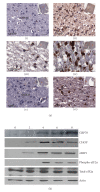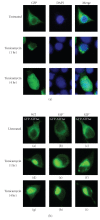Methods for monitoring endoplasmic reticulum stress and the unfolded protein response
- PMID: 20169136
- PMCID: PMC2821749
- DOI: 10.1155/2010/830307
Methods for monitoring endoplasmic reticulum stress and the unfolded protein response
Abstract
The endoplasmic reticulum (ER) is the site of folding of membrane and secreted proteins in the cell. Physiological or pathological processes that disturb protein folding in the endoplasmic reticulum cause ER stress and activate a set of signaling pathways termed the Unfolded Protein Response (UPR). The UPR can promote cellular repair and sustained survival by reducing the load of unfolded proteins through upregulation of chaperones and global attenuation of protein synthesis. Research into ER stress and the UPR continues to grow at a rapid rate as many new investigators are entering the field. There are also many researchers not working directly on ER stress, but who wish to determine whether this response is activated in the system they are studying: thus, it is important to list a standard set of criteria for monitoring UPR in different model systems. Here, we discuss approaches that can be used by researchers to plan and interpret experiments aimed at evaluating whether the UPR and related processes are activated. We would like to emphasize that no individual assay is guaranteed to be the most appropriate one in every situation and strongly recommend the use of multiple assays to verify UPR activation.
Figures




Similar articles
-
Assays for detecting the unfolded protein response.Methods Enzymol. 2011;490:31-51. doi: 10.1016/B978-0-12-385114-7.00002-7. Methods Enzymol. 2011. PMID: 21266242
-
A guide to assessing endoplasmic reticulum homeostasis and stress in mammalian systems.FEBS J. 2020 Jan;287(1):27-42. doi: 10.1111/febs.15107. Epub 2019 Nov 11. FEBS J. 2020. PMID: 31647176 Review.
-
When is the unfolded protein response not the unfolded protein response?Plant Sci. 2017 Jul;260:139-143. doi: 10.1016/j.plantsci.2017.03.014. Epub 2017 Apr 5. Plant Sci. 2017. PMID: 28554471 Review.
-
Endoplasmic reticulum stress and unfolded protein response in inflammatory bowel disease.Inflamm Bowel Dis. 2015 Mar;21(3):636-44. doi: 10.1097/MIB.0000000000000238. Inflamm Bowel Dis. 2015. PMID: 25581827
-
Endoplasmic Reticulum Homeostasis and Stress Responses in Caenorhabditis elegans.Prog Mol Subcell Biol. 2021;59:279-303. doi: 10.1007/978-3-030-67696-4_13. Prog Mol Subcell Biol. 2021. PMID: 34050871
Cited by
-
Behavioral and Molecular Effects of Thapsigargin-Induced Brain ER- Stress: Encompassing Inflammation, MAPK, and Insulin Signaling Pathway.Life (Basel). 2022 Sep 2;12(9):1374. doi: 10.3390/life12091374. Life (Basel). 2022. PMID: 36143409 Free PMC article.
-
Curcumin facilitates a transitory cellular stress response in Trembler-J mice.Hum Mol Genet. 2013 Dec 1;22(23):4698-705. doi: 10.1093/hmg/ddt318. Epub 2013 Jul 11. Hum Mol Genet. 2013. PMID: 23847051 Free PMC article.
-
Induction of endoplasmic reticulum stress response by the indole-3-carbinol cyclic tetrameric derivative CTet in human breast cancer cell lines.PLoS One. 2012;7(8):e43249. doi: 10.1371/journal.pone.0043249. Epub 2012 Aug 14. PLoS One. 2012. PMID: 22905241 Free PMC article.
-
Functional analysis of the impact of ORMDL3 expression on inflammation and activation of the unfolded protein response in human airway epithelial cells.Allergy Asthma Clin Immunol. 2013 Feb 1;9(1):4. doi: 10.1186/1710-1492-9-4. Allergy Asthma Clin Immunol. 2013. PMID: 23369242 Free PMC article.
-
Pharmacological Activation of Nrf2 by Rosolic Acid Attenuates Endoplasmic Reticulum Stress in Endothelial Cells.Oxid Med Cell Longev. 2021 Apr 8;2021:2732435. doi: 10.1155/2021/2732435. eCollection 2021. Oxid Med Cell Longev. 2021. PMID: 33897939 Free PMC article.
References
-
- Ron D, Walter P. Signal integration in the endoplasmic reticulum unfolded protein response. Nature Reviews Molecular Cell Biology. 2007;8(7):519–529. - PubMed
-
- Schroder M, Kaufman RJ. The mammalian unfolded protein response. Annual Review of Biochemistry. 2005;74:739–789. - PubMed
-
- Oikawa D, Kimata Y, Kohno K. Self-association and BiP dissociation are not sufficient for activation of the ER stress sensor Ire1. Journal of Cell Science. 2007;120(9):1681–1688. - PubMed
LinkOut - more resources
Full Text Sources
Other Literature Sources

